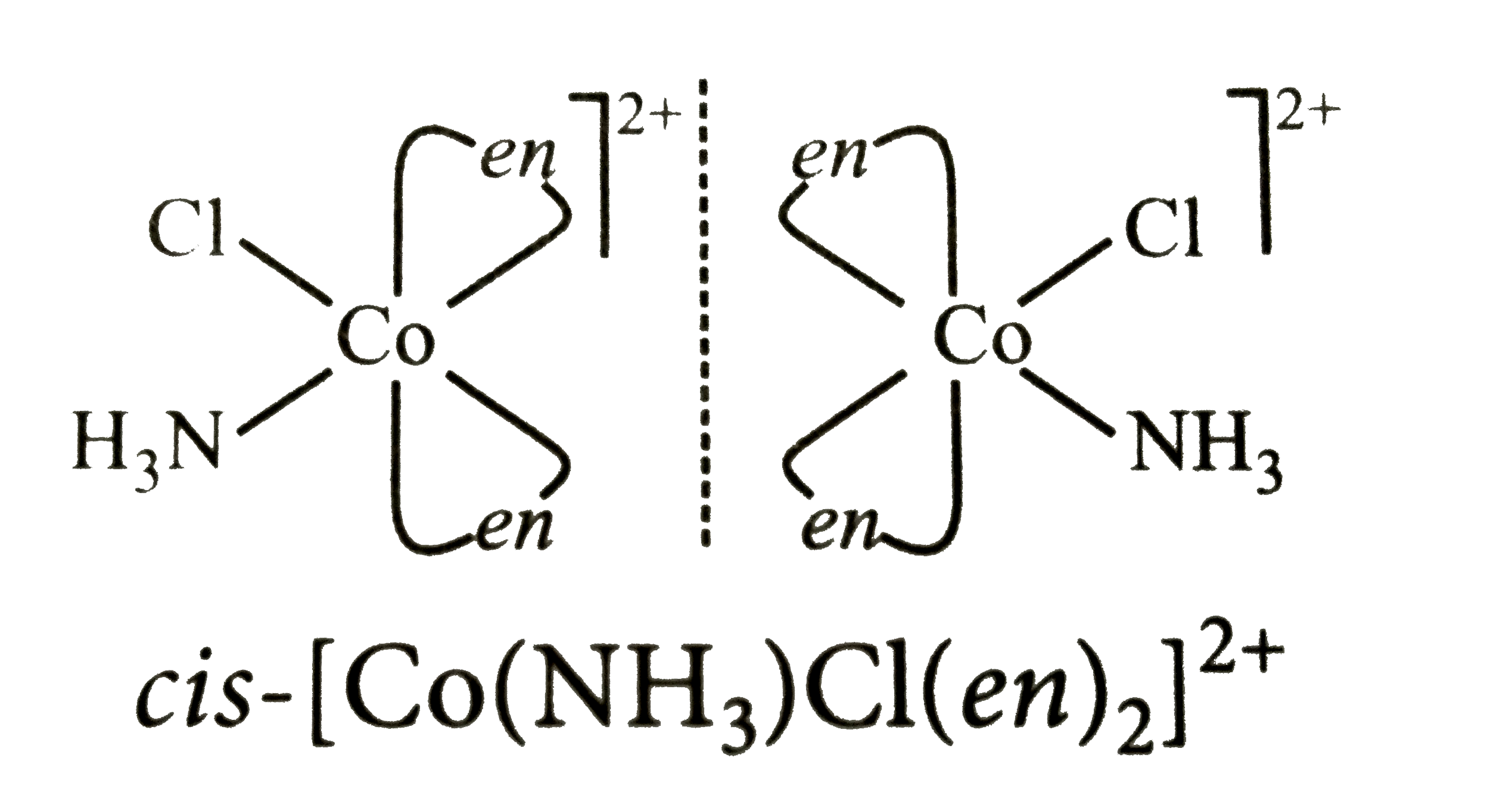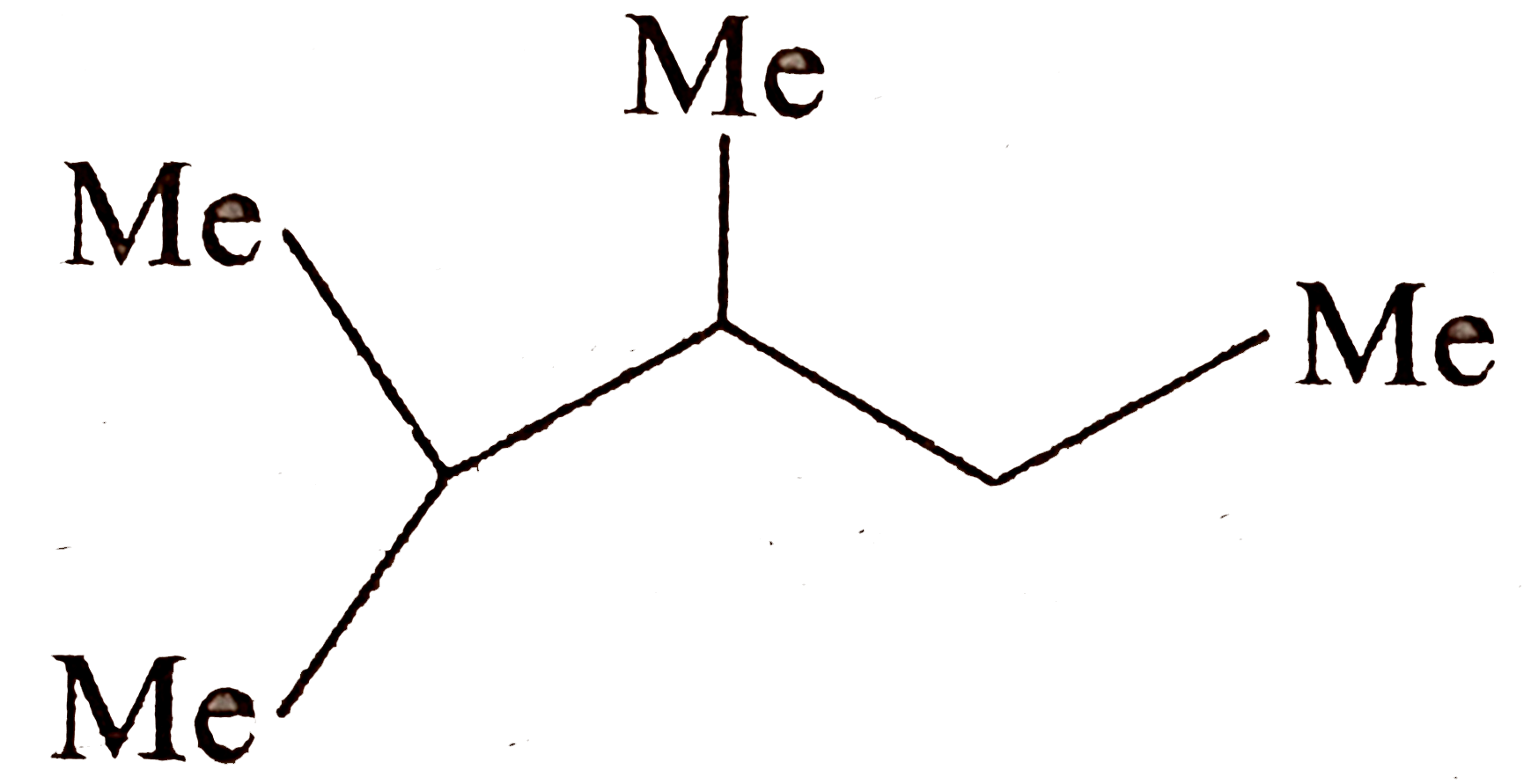[Co(NH3)Cl(en)2]2+ shows two geometrical isomers cis and trans . Which of the following statement is correct ?
trans-isomer will show optical isomerism .
cis-isomer will show optical isomerism .
Both trans and cis-isomers will show optical isomerism .
Neither cis nor trans-isomer will show optical isomerism .
The correct Answer is:B

Trans-[Co(NH3)Cl(en)2]2+ has a plane of symmetry and hence it is optically inactive .
Topper's Solved these Questions
- COORDINATION COMPOUNDS BOOK - NCERT FINGERTIPSCHAPTER - COORDINATION COMPOUNDS EXERCISE - Bonding In Coordination Compounds
40 Videos
- COORDINATION COMPOUNDS BOOK - NCERT FINGERTIPSCHAPTER - COORDINATION COMPOUNDS EXERCISE - Bonding In Metal Carbonyls
5 Videos
- COORDINATION COMPOUNDS BOOK - NCERT FINGERTIPSCHAPTER - COORDINATION COMPOUNDS EXERCISE - Nomenclature Of Coordination Compounds
9 Videos
- CHEMISTRY IN EVERYDAY LIFE BOOK - NCERT FINGERTIPSCHAPTER - CHEMISTRY IN EVERYDAY LIFE EXERCISE - Assertion And Reason
15 Videos
- ELECTROCHEMISTRYBOOK - NCERT FINGERTIPSCHAPTER - ELECTROCHEMISTRYEXERCISE - Assertion And Reason
15 Videos
Similar Questions
How many geometrical isomers are possible in the following coordination entities ?
[Co(NH3)3Cl3]
View SolutionStatement-1: In the reaction [CoCl2(NH3)4]++Cl−→[CoCl3(NH3)3]+NH3, when reactant is in cis-form two isomers of the product are obtained.
Statement-2: Third chloride ions replaces an ammonia cis to both chloride ion or trans to one of the chloride ion.
View Solution
Knowledge Check
If (A) and (C) show geometrical isomers but not optical isomers, and (A) is cis− and (C) is trans − isomer, which of the following is / are correct ?
AThe number of structural isomers for (A) and (C) are three each.BThe number of structural isomer for (A) and (C) are four each.C(B) is racemic and is D(B) is racemic and is
D(B) is racemic and is
Statement-1:[Co(en)(NO2)2(pn)]+ ion exists in four geometrical forms : two are cis and two are trans.
Statement-2:en (symmetrical ligand) and pn (unsymmetrical ligand) are etylene diamine and 1, 2-diamino propane repectively forming complex of the type M(AA)(AB)a2.AStatement-1 is True, Statement-2 is True , Statement-2 is a correct explanation for Statement-1.BStatement-1 is True, Statement-2 is True, Statement-2 is NOT a correct explanation for Statement-1.CStatement-1 is True, Statement-2 is False.DStatement-1 is False, Statement-2 is True.Statement-1:[Co(en)(NO2)2(pn)]+ ion exists in four geometrical forms : two are cis and two are trans.
Statement-2:en (symmetrical ligand) and pn (unsymmetrical ligand) are etylene diamine and 1, 2-diamino propane repectively forming complex of the type M(A A)(AB)a_(2).AStatement-1 is True, Statement-2 is True , Statement-2 is a correct explanation for Statement-1.BStatement-1 is True, Statement-2 is True, Statement-2 is NOT a correct explanation for Statement-1.CStatement-1 is True, Statement-2 is False.DStatement-1 is False, Statement-2 is True.
Statement-1: In the reaction [CoCl2(NH3)4]++Cl−→[CoCl3(NH3)3]+NH3, when reactant is in cis-form two isomers of the product are obtained.
Statement-2: Third chloride ions replaces an ammonia cis to both chloride ion or trans to one of the chloride ion.
View SolutionThe number of geometrical isomers for [Pt(NH3)2Cl2] is
View SolutionConsider the following reaction and statements:
[Co(NH3)4Br2]++Br−→[Co(NH3)3Br3]+NH3
Two isomers are produced if the reactant complex ion is a cis-isomer
Two isomers are produced if the reactant complex ion is a trans-isomer
Only one isomer is produced if the reactant complex ion is a trans-isomer
Only one isomer is produced if the reactant complex ion is a cis – isomer
The correct statements are
View SolutionFour statements for the following reaction given below [CoCl2(NH3)4]+→[CoCl3(NH3)3]+NH3
(P) Only one isomer is produced if the ractant complex ion is a trans isomer
(Q) Three isomers are produced if the reactant complex ion is a cis isomer
(R ) Two isomers are produced if the reactant complex ion is trans isomer
(S) Two isomers are produced if the reactant complex is cis isomer
The correct statements are :
View SolutionFour statements for the following reaction given below [CoCl2(NH3)4]+→[CoCl3(NH3)3]+NH3
(P) Only one isomer is produced if the ractant complex ion is a trans isomer
(Q) Three isomers are produced if the reactant complex ion is a cis isomer
(R ) Two isomers are produced if the reactant complex ion is trans isomer
(S) Two isomers are produced if the reactant complex is cis isomer
The correct statements are :
View Solution
